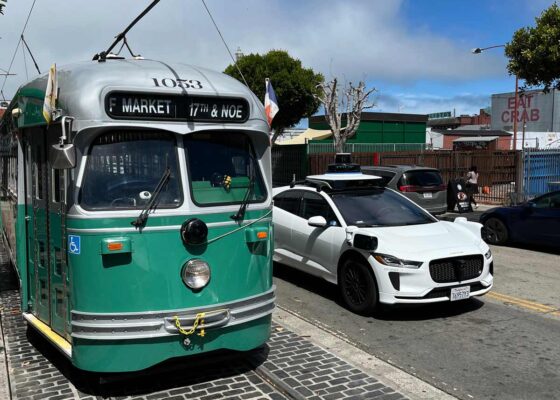Estimated reading time: 6 minutes
Driverless Cars, renewed urban traffic concepts, new business models in and around mobility solutions – discussions about an autonomous future entail all of these vibrant topics, and so did our MaaS Conference in November 2019. Which are the challenges, cities and governments are facing? What technological solutions are already available, and which issues are vehicle manufacturers confronted with? Which role will data and data security take? What does autonomous driving entail for each individual and our everyday lives? And when and how will we get to the autonomous future?
Circling through ideas, thoughts, and knowledge regarding an autonomous future, we looked at it from various perspectives, that we will deep-dive into in our series: Opportunities & Challenges in the Autonomous future. In two previous articles we already discussed technological challenges and necessary societal and regulatory issues. Now, though, after learning a lot about current difficulties, we can’t wait to take a look at the fun stuff:
More than just robo cabs: how autonomous vehicles will shape the way we live.
Autonomous driving will change urban mobility, the way we commute, the way we understand transportation, the way we buy cars. In the autonomous future, our lives will never look the same again! Not only individuals and their everyday life will be affected by the changes, though, but also cities and urban development, business models, and the job market will undergo some changes. Let’s deep-dive into some of these aspects.
With urbanization increasing all around the world, cities must define effective, yet environmentally friendly mobility solutions. In big cities, such as Vienna, which is growing to more than 2 Million in population by 2030, one large trend is “to give the city back to the people, instead of to cars”, as Alexandra Reinagel, CFO of Vienna’s public transport provider Wiener Linien, mentioned at the 2019 MaaS-conference. Wolfgang Pell, in his keynote about Infrastructural Challenges For New Forms of Mobility, adds to that by pointing out, that in Vienna today vehicles cover about 5% of the city’s area, mostly for parking. With autonomous driving technology utilization rates of vehicles will increase drastically, leading to freeing-up of space – space, that can be used for parks, public spaces, new buildings.
While regular vehicles will be expelled from city centres car by car, AVs can be a great solution to fill the gap for individual transportation demands. Of course, public transport will further grow, as it represents the most efficient mobility solution in dense areas. But there will always remain a need for highly individual solutions, which only cars will be able to fulfill. AVs have the great advantage, that they do not take up any parking space, as they can relocate after every tour. When used as Robocabs for maximum utilization, preferably combined with an electric engine and controlled by a smart collaborative software, which helps every citizen to find the right mode of transport, AVs can play an important role in creating an even more livable and loveable future in cities.
For municipalities though, the increase in efficiency regarding traffic, the utilization rate of autonomous vehicles, or their technologically granted sticking to the rules such as speed limits, causes some rather unexpected issues: many cities today make a lot of money from parking tickets and speeding tickets. One example here is the city of Hamburg earning about 30 Mio. € each year only from illegal parking fines. With autonomous cars, parking only in allowed spots and never exceeding speed limits, this source of income will decrease drastically and rip some holes into public purses. Thus, cities will need to get a little creative here. City tolls could be a solution. London, for instance, has already installed a city toll, valid only in certain areas in the city and during highly frequented times of the day. This solution not only provides an alternative source of income to cities but is also aimed towards increasing the use of public transport and thus shifting and regulating some of the traffic to avoid traffic jams during rush hours.
When driverless cars will slowly start to replace non-autonomous vehicles, several jobs will be concerned: taxi-, uber and bus drivers, but also jobs like traffic police will become less common, whilst in other places more experts will be necessary, for instance in fleet management, IT, traffic control centers, or even the cleaning of cars and hygiene. The latter playing an increasingly important role for car sharing, just think about the impacts of the current Covid19-pandemic. A McKinsey study in collaboration with the city of Berlin on the impacts of autonomous technology expects an overall increase in jobs, though.
And obviously, driverless cars will not only impact some jobs directly, but also the way every single one of us works in their daily jobs, or uses the time we need to get from A to B. Today EU citizens spend on average 40 min in their car every single day. If only half of this time could be used to actually work, online shop, or consume entertainment, experts estimate that only within the European Union up to € 1 billion a day (!) of additional earnings could be possible.
Challenges and opportunities aside: the autonomous future will keep on thriving
Forecasts say that from 2030 on fully autonomous vehicles will be part of urban mobility. McKinsey estimates that between 2040 and 2050 autonomous cars will even start to outnumber non-autonomous vehicles and cover up to 90% of all rides in urban surroundings. Reading the above mentioned arguments it becomes obvious, that we still have to solve many questions and issues on our way to an autonomous future. Simultaneously, though, we already are in the middle of a massive change in mobility – autonomous technology is without any doubt on the rise and will keep on changing the way we move and the way we live.
What we’ve learned so far:
- Car manufacturers still face several issues regarding the technology. Unexpectedly, the solutions we are provided with today are not as refined as experts expected them to be until a few years ago. (Go to article Part I: Is Autonomous Driving Really Ready for the Street?)
- Regarding legislation and liability there are several complex questions to be answered, before we can fully rely on autonomous vehicles in our everyday lives. (Go to article Part II: How Can Self-Driving Cars Fit into our Society?)
- Cities, companies, and governments will need to adapt and become creative when it comes to the changes in society and mobility caused by autonomous driving: this affects not only the job market, business models and traffic management, but also urban development and the usage of certain areas.
An autonomous future does not only depend on one player. As Wolfgang Pell, managing director of VERBUND Solutions and speaker at the 2019 MaaS conference put it “The alignment of technology, people and cities is crucial to form new mobility solutions, convenience being top priority regarding the shift to an autonomous future”. Thus, the combination and network between the automotive industry, cities, governments, the energy sector and many more is crucial to enable our society as a whole to live and work in an autonomous future. This fits perfectly with the vision of accilium as a company: built to evolve, we are aiming to find our spot in the middle of those key players and help orchestrate future mobility.






 ISO/IEC 27001:2013 certified
ISO/IEC 27001:2013 certified